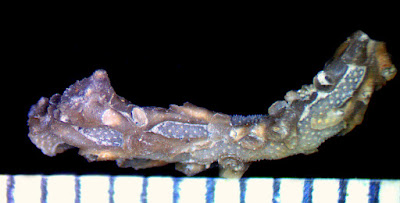The image shows an Anthonomus defossus (Scudder, 1876) snout nosed beetle insect fossil found in the Florissant Formation of Teller County, Colorado, USA. It dates to the Chadronian Stage (37.2 - 33.9 million years ago) of the Eocene Epoch of the Paleogene Period. Thanks to Doug for the image. Field of view (FOV) is 2 mm.
Pages
Sunday, December 26, 2021
Saturday, December 25, 2021
Lacewing Insect Fossil
The image shows a lacewing insect fossil found in the Florissant Formation of Teller County, Colorado, USA. It dates to the Eocene Epoch of the Paleogene Period. Thanks to Doug for the image. Field of view (FOV) is 6 mm.
Merry Christmas everybody!
Tuesday, December 21, 2021
Trading Places in a Devonian Sea
My cousin Kenny sent me some pictures of some fossils he screened from micro material I brought back from Alpena Michigan USA. What I found interesting was two specimens show the interactions between bryozoan and coral fossils. One specimen shows a coral growing on a bryozoan and another shows the reverse. First picture shows an Aulopora (Goldfuss, 1829) coral growing on what appears to be a Fistulipora (McCoy, 1849) bryozoan. The next image shows an Aulocystis ramosa with a matting Fistulipora bryozoan growing on top of it.
The next image shows the same type of coral fossil with a matting bryozoan. Field of view (FOV) in these images is about 12-15 mm.
Sunday, December 19, 2021
Strophondonta crassa Brachiopod Fossil
Thanks to Kenny for image and screen material to find fossil.
Thursday, December 9, 2021
Marrella splendens Arthropod Image
This image created by Doctor Elvira Wood and published in 1920 in The Appendages, Anatomy, and Relationships of Trilobites by Percy E. Raymond. It is of a Marrella splendens (Walcott, 1912) arthropod. Charles Doolittle Walcott collected it from the Burgess Shale of British Columbia, Canada in 1909. He described it as a "lace crab". It turns out it is not a trilobite or a crab. The creature lived in the Cambrian Period.
This image is not correct as you will see if go to the Wikipedia entry below to see more modern interpretations of what this animal looked like. Dr. Raymond was directing Dr. Wood how to illustrate this fossil. He writes on page 116, "The accompanying restoration of the ventral surface of Marrella is a tentative one, based on Doctor Walcott's description and figures. ... The restoration is therefore subject to revision as the species becomes better known."
Learn more at: https://en.wikipedia.org/wiki/Marrella
Sunday, December 5, 2021
Hexagonaria Coral with Hederella Bryozoan Fossils
These pictures are of a Hexagonaria anna (Whitfield, 1973) coral fossil. It was found in the Bell Shale of the Traverse Group of Alpena, Michigan, USA. The coral lived in the Devonian Period. On the bottom of the coral is a small colony (3 cm long) of Hederella (Hall, 1883) bryozoans.












